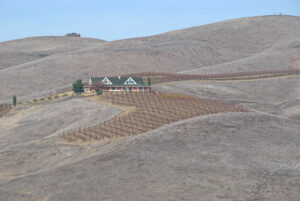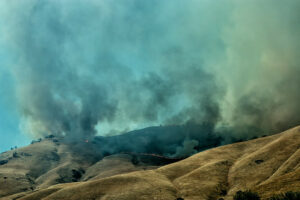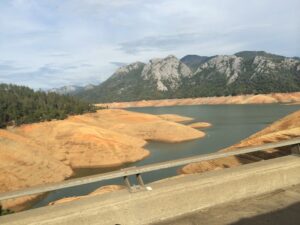Historic Drought Poses Risks for Nation’s Food Supply and Local Communities
This article is part of a three-part series, which includes a closer look from Wyoming and a perspective from the Pacific Northwest. To watch the recording of our recent Livestream conversation on this topic, “Drought, Wildfires, and Climate Change: The Future of Farming in the West,” click here.
Vast swaths of the West remain in a historic and unrelenting drought; the region’s worst in at least 20 years, reports CNN. The most severe conditions are centered in the Southwest, California, Nevada, Utah, and Arizona. But areas of extreme and exceptional Pacific Northwest drought extend north, as well as into Oregon and Washington.

This year’s severe drought is leading farmers and ranchers to fallow lands, switch to less water-intensive crops, or farm on fewer acres. Cattle producers, whose pastures are nearly barren, are selling off their cattle since they have nothing to feed them. California farmer Joe Del Bosque worries about laying off hundreds of farm workers in this recent Reuters article, as his farm waits anxiously for water deliveries.
Ranchers are trucking water and supplemental feed for their livestock, because the rangelands are so dry and the vegetation is stunted. In Rio Vista, California, the drought on Ryan Mahoney’s ranch is the worst they have seen in recent history, reports a recent National Geographic article.
“According to my grandpa, who is 92 this year, this is the worst he’s ever seen in the Montezuma Hills,” Mahoney says. “Typical rainfall is 16 to 18 inches. We got three to five inches this year, and [the impact] is pretty drastic and dramatic.”
Food Prices and Availability
Impacts from the drought and other climate-related disasters have serious implications for the area’s food availability and prices, as the affected region accounts for about a third of the monetary value of U.S. agricultural production.
Conditions are especially dire in California, where the 2015 drought resulted in $1.84 billion in direct costs, a loss of 10,100 seasonal jobs, and surface water shortages of 8.7 million acre-feet. Currently, the state’s reservoirs hold about half as much water as usual for this time of year.

The federal government has cut water allocations from its huge Central Valley Project to California cities and farmers by 75 percent. In the San Joaquin Valley, as aquifers drop, current levels of agricultural water use are untenable, impacting local communities’ access to drinking water. On the Oregon border, there is not enough water for both endangered fish and farmers.
Wildfires, at sizes usually seen later in the summer, are already occurring in California, Arizona, and New Mexico with concerns that this summer’s wildfires will be severe and widespread.
The Need for Solutions
The severity of the problem requires collaboration and innovative solutions.
Farmers and Ranchers need to continue to improve water use efficiency during Pacific Northwest droughts:
Nearly 40% of California’s 24.6 million acres of farmland are irrigated, with crops like almonds and grapes in some regions needing more water than others.
“Water use efficiency on California’s farms and ranches has improved significantly,” reports CDFA Secretary Karen Ross. “Investments and on-farm innovations have resulted in more than 14% reduction in agricultural water use since 1980, while at the same time increasing food production by 38%.”
Local jurisdictions should place a high priority on protecting agricultural land:

Farm and ranch land not only emits less greenhouse gases than an urban acre, according to AFT research. Conserving agricultural land also provides critical groundwater recharge zones, which help preserve existing dwindling water supplies. Well-managed grazing land and irrigated crop land have been proven to slow the spread of wildfire. Visit AFT’s Saving Farmland, Growing Cities webpage for a variety of resources related to effectively planning for agriculture and water resources in your area.
State and Federal governments should provide adequate resources to ameliorate and adapt to climate change impacts:
State governments across the west and the federal government can invest more aggressively in programs, which support regenerative agricultural practices, agricultural protection, and transition.
Two recent examples are USDA’s emergency loans and recent drought funding for several western states, including almost 400 counties in Arizona, Colorado, California, New Mexico, Nevada, and Wyoming. The natural disaster designations make producers and ranchers eligible for USDA emergency loans, which can allow them to replace equipment and livestock if they need, or assistance for financial reorganization.
Currently four states — Oregon, California, Colorado, and Arizona — are allowed to apply for 41.8 million in federal aid through the USDA program, Environmental Quality Incentives Program (EQIP), which helps producers pay for conservation projects to protect natural resources and improve drought resilience.
For more information go here and apply before July 12.
Local, state and federal agencies must deploy funding and technical assistance programs swiftly and effectively on the ground to those in need:
Funding programs require adequate boots on the ground to provide effective services to help agriculture. Farmers and ranchers can start by contacting their local resource conservation or soil and water conservation district, and their USDA Natural Resources Conservation Service and Farm Service Agency field offices.
In California’s San Joaquin Valley, AFT will be working with local partners and the Natural Resources Conservation Service to provide technical assistance and funding to farmers to protect soil and water resources and agricultural land through our San Joaquin Land and Water Strategy.

